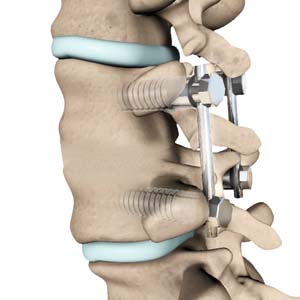Posterior Spinal Fusion

What is Spinal Fusion?
Spinal fusion is the surgical technique of combining two or more vertebrae. Fusion of the vertebrae involves insertion of secondary bone tissue obtained either through auto graft (tissues from the same patient) or allograft (tissues from the other person) to augment the bone healing process.
Indications for Lumbar Spinal Fusion
Usually spinal fusion is recommended in patients with neurological problems or severe pain that have not responded to conservative treatment. Various spinal conditions may be treated though lumbar spinal fusion such as:
- Spinal stenosis
- Damaged disc
- Spinal tumor
- Fractures of the spine
- Scoliosis and Kyphosis (abnormal curvatures of the spine)
Lumbar Spinal Fusion Procedure
Spinal fusion can be performed through different angles depending upon the specific advantages of each and the choice of your surgeon. It may involve Interbody fusion where bone graft is placed in the space present between the two vertebras. Other techniques may also be employed for spinal fusion that involves the entire removal of the disc between the affected vertebrae. A specially designed device made either from plastic or titanium may be placed between the vertebrae. This helps in maintaining spine alignment and normal height of the disc.
The fusion process is followed by fixation that involves fitting of metallic screws, rods, plates or cages to stabilize the vertebrae and accelerate bone fusion. After surgery, 6-12 months is the ideal time for complete fusion to take place.
Complications of Lumbar Spinal Fusion Procedure
The complications associated with spinal fusion include infection, nerve damage, blood clots or blood loss, bowel and bladder problems and problems associated with anesthesia. The primary risk of spinal fusion surgery is failure of fusion of vertebral bones which may require an additional surgery.
Talk to your surgeon if you have concerns regarding spinal fusion procedure.


